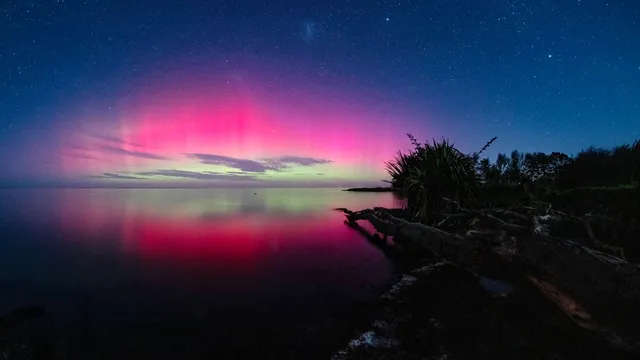
Bright green meteor dazzles Sydney skies during auroras
2025-06-02 05:51- A bright green meteor was spotted over Sydney on June 1, 2025.
- This event coincided with spectacular auroras observed in Australia and New Zealand.
- Astronomers predict ongoing geomagnetic activity may continue in the following days.
Express your sentiment!
Insights
On Sunday, June 1, 2025, a bright green meteor, approximately the size of a basketball, was seen traversing the skies of Sydney, Australia. The meteor was captured on video by local resident Tom McCallister, who observed it moving from east to west at around 5:57 PM local time. Astrophysicist Brad Tucker from the Australian National University confirmed the object's identification as a meteor, citing its distinctive blue-green color, which indicates the presence of iron and nickel. This sighting coincided with a series of spectacular auroras lit up across Australia and New Zealand as a result of geomagnetic storms triggered by a powerful coronal mass ejection (CME) from the Sun that occurred on the preceding Friday. The phenomenon of the aurora australis, visible primarily in southern latitudes, was also shared by numerous skygazers who posted photos on social media, showcasing the dance of lights in vibrant hues of pink, red, and green, with hints of yellow. The dynamic colors are produced by atmospheric molecules being charged by the Earth's magnetic field, with oxygen causing the fluorescent green and nitrogen leading to blue, red, or pink tints. Auroras occur when intense solar storms strike the Earth, and their visibility is usually heightened in regions closer to the poles where the magnetic field is strongest. The increased auroral activity was anticipated due to reports from astronomers predicting a strong geomagnetic storm on the same day, a pattern which often follows significant solar eruptions. The National Oceanic and Atmospheric Administration (NOAA) indicated that the conditions for a severe geomagnetic storm could still be brewing, even suggesting that there might be fluctuations of G3-G4 severe storm levels in the coming days. A coronal mass ejection, which releases large quantities of charged plasma from the Sun, had been noted as a significant precursor to the auroras seen over this time frame. As a result of these solar phenomena, the northern hemisphere experienced aurora borealis displays, extending far down into the continental United States, even reaching regions such as Alabama. The NOAA has remarked that while the activity level from the CME may lessen, the ongoing solar wind conditions suggest the possible continuation of auroras and geomagnetic activity in the near future. The Sun is nearing the peak of its 11-year solar cycle, making such events more common as solar activity escalates, leading to similarly captivating experiences for skywatchers in both hemispheres.
Contexts
Auroras are captivating natural light displays predominantly observed in polar regions, resulting from the interaction between charged particles from the sun and Earth's magnetic field and atmosphere. These charged particles, primarily electrons and protons, are ejected from the sun during solar events like coronal mass ejections or solar winds, which propel them towards Earth. When these particles collide with atmospheric gases, such as oxygen and nitrogen, they transfer energy to these atoms, resulting in the emission of light and producing the mesmerizing colors typically associated with auroras. The formation of auroras occurs in several steps. Firstly, the solar wind carries solar particles through space, with a majority of these particles reaching the Earth due to its magnetic field. When the solar wind encounters the Earth’s magnetosphere—an area dominated by the Earth's magnetic field—it can cause the field to be disturbed, allowing some of these particles to funnel towards the polar regions. As the charged particles descend into the upper atmosphere, they collide with gas molecules at altitudes of 80 to 300 kilometers, creating the spectacular auroral displays we see. The variations in color in auroras often depend on the type of gas involved and the altitude at which the collisions occur. The color of the auroras, ranging from greens to pinks, reds, purples, and blues, is dictated by the type of gas in the atmosphere that the solar particles interact with. Oxygen at higher altitudes (above 150 km) can emit red and purple hues, while at lower altitudes (around 100 km), it produces the common green seen in many auroras. Nitrogen, on the other hand, can produce purples and blues, contributing to the rich palette observed during these events. Moreover, the intensity and activity level of the solar wind can significantly affect the brightness and extent of the auroral display, with stronger solar winds leading to more vivid and expansive auroras. Understanding auroras not only fascinates scientists and the general public alike but also plays a critical role in studying the complex interactions within our solar system. Tracking solar wind activity and auroral patterns helps researchers predict disturbances in Earth's magnetosphere that could impact satellite operations, communication systems, and even power grids on Earth. As we continue to explore the dynamics of solar and terrestrial phenomena, the study of auroras provides invaluable insights into the intricate relationship between our planet and the sun.